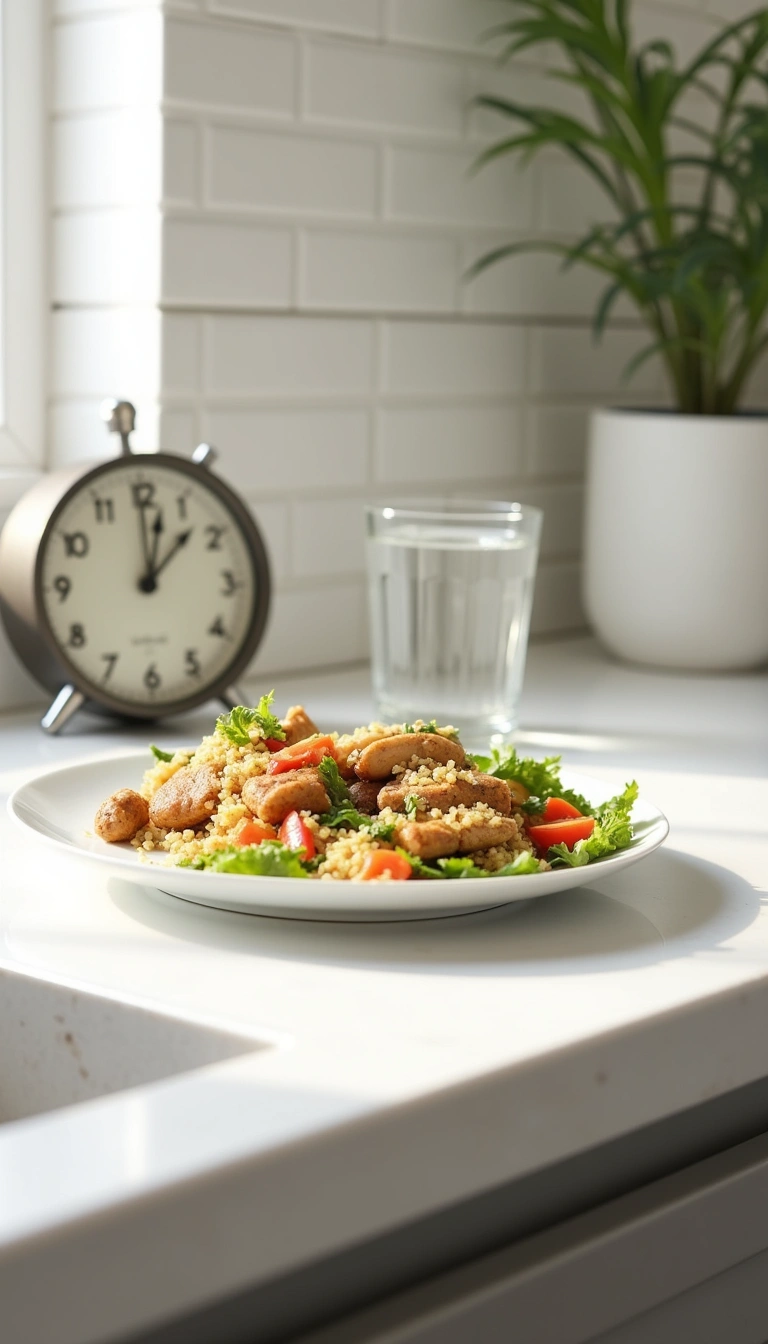An intermittent fasting meal plan 16:8 can transform your eating habits without complicated diet rules. Many people struggle with weight management and constant hunger throughout the day. This eating pattern offers a simple solution by limiting when you eat, not just what you eat. You’ll discover how this approach can fit seamlessly into your daily routine.
What Is the 16:8 Intermittent Fasting Method?

The 16:8 method is the most popular form of intermittent fasting. You fast for 16 hours and eat all your meals within an 8-hour window each day.
Think of it as extending your overnight fast. Instead of eating breakfast at 7 AM, you might start eating at 12 PM and finish by 8 PM. This creates your 16-hour fasting window from 8 PM to 12 PM the next day.
Take Charge of Your Health with The Home Doctor
Discover real-world remedies and first-aid solutions you can use when help isn’t around.
👉 Claim Your Home Doctor GuideDuring your fasting hours, you can drink water, black coffee, or plain tea. These beverages won’t break your fast and help you stay hydrated throughout the morning.
How It Works in Your Body
When you fast for 16 hours, your body shifts from burning glucose to burning stored fat. This metabolic switch typically happens 12-14 hours after your last meal.
Your insulin levels drop during the fasting window, making it easier for your body to access fat stores. This natural fat burning process can support healthy weight management over time.
Health Benefits of 16:8 Intermittent Fasting
Research shows that this eating schedule offers several potential health advantages. Weight loss is often the most noticeable benefit people experience within the first few weeks.
Studies suggest that intermittent fasting may improve insulin sensitivity and blood sugar control. This can be particularly helpful for people with prediabetes or type 2 diabetes, though you should consult your doctor first.
Mental and Physical Benefits
Many people report increased mental clarity during their fasting hours. Without constant digestion, your body can focus energy on other important functions.
Your metabolism may become more efficient at switching between fuel sources. This flexibility can lead to more stable energy levels throughout the day.
Some research indicates that intermittent fasting might support cellular repair processes and reduce inflammation markers in the body.
Getting Started: Your First Week
Begin gradually to help your body adjust to the new eating schedule. Start with a 12-hour fast and extend it by 30 minutes every few days until you reach 16 hours.
Choose an 8-hour eating window that fits your lifestyle. Popular options include 12 PM to 8 PM, 1 PM to 9 PM, or 11 AM to 7 PM.
Timing Your Eating Window
Consider your work schedule and family meals when selecting your hours. If you have dinner with family at 7 PM, ending your eating window at 8 PM works well.
Morning exercisers might prefer an earlier window like 10 AM to 6 PM. Evening workout enthusiasts often choose 1 PM to 9 PM to fuel their training sessions.
Consistency matters more than perfect timing. Pick a schedule you can maintain most days of the week.
Sample 7-Day Intermittent Fasting Meal Plan
This meal plan uses a 12 PM to 8 PM eating window. Adjust the timing to match your chosen schedule while keeping the same meal structure.
Day 1
12 PM (First Meal): Greek yogurt with berries and almonds
3 PM (Snack): Apple slices with peanut butter
6 PM (Dinner): Grilled chicken breast, roasted vegetables, and quinoa
7:30 PM (Optional): Small handful of nuts
Day 2
12 PM: Vegetable omelet with spinach and cheese
3 PM: Carrot sticks with hummus
6 PM: Baked salmon, sweet potato, and steamed broccoli
7:30 PM: Herbal tea with a few dates
Day 3
12 PM: Smoothie with protein powder, banana, and spinach
3 PM: Mixed nuts and dried fruit
6 PM: Turkey and vegetable stir-fry over brown rice
7:30 PM: Small piece of dark chocolate
Days 4-7
Continue rotating similar healthy meals within your eating window. Focus on whole foods, lean proteins, healthy fats, and plenty of vegetables.
Meal prep on weekends to make weekday eating easier. Prepare proteins, chop vegetables, and portion snacks in advance.
Managing Hunger and Cravings
Hunger pangs are normal during your first week of fasting. Your body needs time to adjust to the new eating schedule.
Drink plenty of water throughout your fasting window. Sometimes thirst masquerades as hunger, and proper hydration can reduce cravings.
Strategies That Work
Keep busy during your fasting hours with work, hobbies, or light exercise. Distraction is one of the most effective tools for managing hunger.
Black coffee or green tea can help suppress appetite naturally. The caffeine provides energy while the warm liquid creates a feeling of fullness.
Remember that hunger comes in waves. If you feel hungry at 10 AM, it will likely pass within 20-30 minutes without eating.
What to Eat During Your 8-Hour Window
Focus on nutrient-dense whole foods to maximize the benefits of your limited eating time. Quality matters more than quantity when you have fewer hours to eat.
Include protein at each meal to help you feel satisfied and maintain muscle mass. Good options include eggs, fish, chicken, beans, and Greek yogurt.
Building Balanced Meals
Fill half your plate with vegetables at lunch and dinner. These provide essential vitamins, minerals, and fiber while keeping calories reasonable.
Add healthy fats like avocado, olive oil, nuts, and seeds. These help you feel full and support the absorption of fat-soluble vitamins.
Choose complex carbohydrates such as quinoa, brown rice, and sweet potatoes. These provide steady energy without causing blood sugar spikes.
Common Mistakes to Avoid
Don’t compensate for fasting by overeating during your eating window. This can negate the benefits and leave you feeling uncomfortable.
Avoid processed foods and sugary snacks, even within your eating hours. These can trigger cravings and make fasting more difficult the next day.
Setting Realistic Expectations
Progress takes time, so don’t expect dramatic changes in your first week. Most people notice increased energy and reduced bloating before seeing weight changes.
Listen to your body and adjust as needed. If you feel dizzy or extremely fatigued, consider shortening your fasting window temporarily.
Stay flexible with your schedule. If you have a special event or family gathering, it’s okay to adjust your eating window occasionally.
Staying Hydrated and Energized
Proper hydration becomes even more important when you’re intermittent fasting. Aim for at least 8 glasses of water throughout the day.
Add a pinch of sea salt to your water if you experience headaches during fasting. This can help maintain electrolyte balance.
Beverages During Fasting
Stick to zero-calorie drinks during your 16-hour fast. Water, black coffee, and plain tea are your best options.
Avoid artificial sweeteners if they trigger cravings or digestive issues. Some people find that even zero-calorie sweeteners make fasting more challenging.
Herbal teas like peppermint, chamomile, or ginger can provide variety and help with any digestive discomfort.
Exercise and Intermittent Fasting
You can absolutely exercise while following the 16:8 method. Many people find they have more energy for workouts during their fasting state.
Light to moderate exercise like walking, yoga, or swimming works well during fasting hours. Save intense workouts for closer to your eating window.
Timing Your Workouts
If you exercise in the morning while fasting, plan to break your fast within 2 hours after your workout. This helps with recovery and muscle protein synthesis.
Evening exercisers can work out before dinner and use their post-workout meal as part of their eating window. This timing supports both performance and recovery.
When to Seek Medical Advice
Consult your healthcare provider before starting intermittent fasting if you have diabetes, eating disorders, or take medications. These conditions may require special considerations.
Pregnant and breastfeeding women should avoid intermittent fasting. Growing children and teenagers also need consistent nutrition throughout the day.
Stop fasting and seek medical attention if you experience persistent dizziness, extreme fatigue, or any concerning symptoms.
Troubleshooting Common Challenges
Social situations can make sticking to your eating window difficult. Plan ahead by checking restaurant menus or eating before social events if needed.
Travel across time zones may disrupt your schedule temporarily. Focus on maintaining the 16-hour gap rather than specific clock times when traveling.
Plateau Solutions
If weight loss stalls after several weeks, consider varying your eating window times or incorporating different types of exercise. Your body adapts to routines over time.
Track your non-scale victories like improved sleep, better digestion, or increased energy levels. These benefits often continue even when weight loss slows.
Long-Term Success Tips
Make intermittent fasting a lifestyle rather than a short-term diet. Focus on how it makes you feel rather than just the numbers on the scale.
Build flexibility into your approach. Having 80% consistency is better than giving up entirely after a few imperfect days.
Connect with others who practice intermittent fasting for support and motivation. Online communities and local groups can provide valuable encouragement.
Your intermittent fasting journey starts with a single 16-hour fast. Take it one day at a time, listen to your body, and celebrate small victories along the way. This sustainable approach to eating can become a natural part of your healthy lifestyle.

Sandra Hernandez, a resident of New York, is an active contributor on lifebing.com. Her passion for knowledge fuels her writing journey as she delves into fascinating topics that capture her curiosity.
